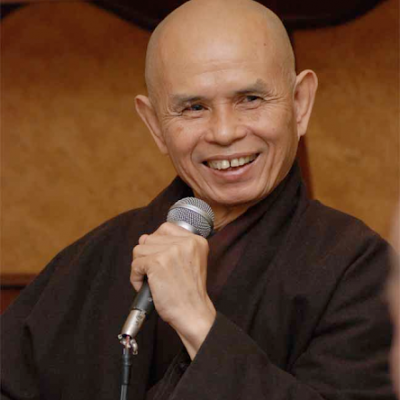Thay in India

Thich Nhat Hanh, Ahimsa Trust and Thay in India: 1988, 1997 and 2008
Thay and Ahimsa Trust
Ahimsa Trust was set up in 1996 as a social, educational and cultural not for profit NGO (Non-Governmental Organisation). Ahimsa is an ancient Indian ethical precept of not causing harm by one’s body, speech and mind. It is common to Hindu, Jain and Buddha Dharmas. It was also a foundation of Gandhi Ji’s mass movement for India’s independence. He sometimes defined it to mean ‘the largest love, the greatest charity’.
When Thay offered to come to India in 1997, Ahimsa Trust decided to host him and organise his events and outreach in India as a peacemaker, author and beloved teacher. Ahimsa continues to support and represent Thich Nhat Hanh and the Plum Village community in India. Since 1997, an increasing number of small groups/sanghas have developed in and around Delhi, Dehradun and other parts of India who meet for regular mindfulness practice sessions.
Ahimsa arranges for the publication of Thich Nhat Hanh’s books and the dissemination of his writings in India in English and a number of local languages, including Hindi, Marathi, Tamil, Malayalam and Bengali. Thay very generously offers the royalties of his books published in India as a donation to Ahimsa Trust.
Thay was keen to bring back the Indian pedagogical approach of mindfulness and applied ethics into the education system globally. Ahimsa has pioneered a Mindfulness in Education movement, which is based on mental training to bring a non-judgemental moment to moment awareness of what is going on within and outside of oneself. The energy that develops through this training of the mind allows students, teachers, parents and administrators to develop a sense of well-being through social, emotional and applied ethical learning.
Ahimsa have held many retreats and workshops, many led by the Plum Village and Ahimsa monastics/teachers, linked to the WakeUp Schools movement. These have been national retreats nearly every year since 2008. In the last few years a number of the retreats for the Paramilitary Armed CRPF (Central Reserve Police Force) and local police forces in states like Uttarakhand and Haryana have also been held. Many of the teaching tours by the monastics of the Plum Village centres have been linked to pilgrimages to the Buddhist sites.
To help children and others experience living in an environment of mindfulness, Ahimsa is setting up the Jamun Village Mindfulness Practice Centre in the village of Rajpur near Dehradun in the Indian hill state of Uttarakhand.
Thich Nhat Hanh was keen that a Mindfulness Practice Centre in the tradition of Plum Village be set up in India. There was a search and different options were looked at, in places like Vaishali and Varanasi. It was finally decided to start in Dehradun, in the foothills of the Himalayas, as Dehradun is the educational capital of North India.

Inspired by Thay and Plum Village, Jamun Village is being developed as an educational, spiritual and socio-ecological centre; a place of refuge, training and compassionate action. There would be a living community of teachers and practitioners who will help instruct in ethical mindful living and self exploration in the context of living in harmony with oneself, others and nature. A space for right livelihood through non-violent means.
The land was blessed by Thich Nhat Hanh at the end of September 2008. Help us make this vision a reality.



On 26th May 2021, Ahimsa Trust and the Plum Village community collaborated for Ahimsa’s 25th Buddha Purnima Anniversary. People from all over the world joined us for this beautiful commemoration. Dharma Talks, Chanting and Practices were offered by Brother Phap Lai, Brother Bao Tich, the monastics of Plum Village, Dharmacharya Shantum and volunteers of Ahimsa Trust.
https://plumvillage.org/articles/updates-from-india-celebrating-vesak-in-a-time-of-suffering/
Thay in India: 1988, 1997, 2008
Thich Naht Hanh visited India in 1988. He had just completed writing the biography of the Buddha titled ‘Old Path White Clouds’ and wanted to offer his gratitude to his teacher, the Buddha and visit the sites associated with his life. Thay invited 30 of his students from around the world and they spent around 35 days in India. He requested his student Shantum Seth to organise the pilgrimage.


Indian Editions of Old Path White Clouds in Hindi and English
The journey started in New Delhi with a Dharma talk and walking meditation session led by Thay at 8 Rajaji Marg at the home of Justice Leila Seth and her family. He also visited Gandhi Smriti, where Mahatma Gandhi had lived the last days of his life and been martyred.
From New Delhi the group moved to Sarnath, Bodhgaya, Rajgir, Nalanda, Patna, Vaishali, Kushinagar, Lumbini, Kapilavastu, Sarvasti and then back to New Delhi via Lucknow.
This pilgrimage was a most intimate journey with Thay and we all felt that that we were travelling with someone who knew the Buddha personally. He wanted to visit local markets, villages and feel the energy of the spaces the Buddha had inhabited. Each place we went, Thay had a child-like energy in sharing his love for his beloved teacher with the group.
At each of the sites associated with the Buddha’s life, Thay offered talks and stories, bringing the Buddha alive. Each day started with a morning meditation practice at one of the sacred sites. Everywhere we walked, we walked in mindfulness. We were walking in the Footsteps of the Buddha, both as an inner and outer journey, both in the present and historically 2,600 years ago.
In Rajgir, the first three monastics in the Order of Interbeing were ordained on Vulture Peak. They included Sister Chan Khong and Sister Annabel. Five people received 14 Mindfulness Trainings and some the 5 Mindfulness Trainings, including Shantum, Thay’s Indian student who had organised the whole journey.

After Sr. Chan Khong, Sr. Chan Duc and Sr. Chan Vi’s ordination on Vulture Peak, 1988
After the pilgrimage in Bihar, Uttar Pradesh and Southern Nepal, the whole group visited the ancient and exquisite rock cut Buddhist caves at Ajanta in Central India.
Thereafter, Thay led a three day retreat organised by the TBMSG, ( Trailokya Bauddha Mahasangha Sahayaka Gana) headed by Dhammachari Lokamitra, at their retreat centre near the second century BCE Bhaja Caves with followers of Dr Ambedkar, before returning to Plum Village
 Thay teaching under a Bodhi Tree at the Mahabodhi temple, Bodh Gaya
Thay teaching under a Bodhi Tree at the Mahabodhi temple, Bodh Gaya
 Thay and Shantum holding hands with the beggar girl, Sunita, while Sister Dinh Nghiem provides shade.
Thay and Shantum holding hands with the beggar girl, Sunita, while Sister Dinh Nghiem provides shade.
 Thich Nhat Hanh offering a talk at the Birla Sabhaghar, Kolkata on 16th November, 1997
Thich Nhat Hanh offering a talk at the Birla Sabhaghar, Kolkata on 16th November, 1997
 Thay leading walking meditation on Raj Path from Rashtrapati Bhavan to India Gate, New Delhi, 2008
Thay leading walking meditation on Raj Path from Rashtrapati Bhavan to India Gate, New Delhi, 2008
 Transmitting the 14 Mindfulness Trainings on Vulture Peak, Rajgir, 2008
Transmitting the 14 Mindfulness Trainings on Vulture Peak, Rajgir, 2008
